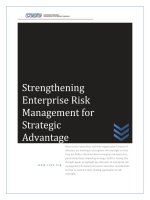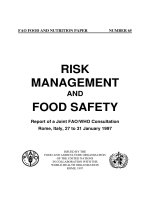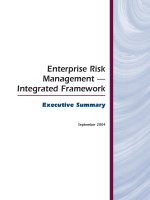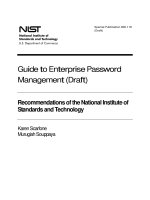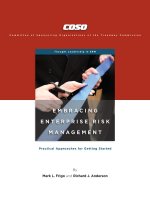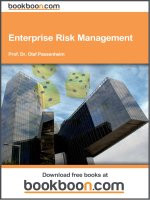enterprise risk management — integrated framework
Bạn đang xem bản rút gọn của tài liệu. Xem và tải ngay bản đầy đủ của tài liệu tại đây (229.39 KB, 49 trang )
Applying COSO’s
Enterprise Risk Management —
Integrated Framework
September 29, 2004
Today’s organizations are
concerned about:
•
Risk Management
•
Governance
•
Control
•
Assurance (and Consulting)
ERM Defined:
“… a process, effected by an entity's
board of directors, management and
other personnel, applied in strategy
setting and across the enterprise,
designed to identify potential events that
may affect the entity, and manage risks
to be within its risk appetite, to provide
reasonable assurance regarding the
achievement of entity objectives.”
Source: COSO Enterprise Risk Management – Integrated Framework. 2004.
COSO.
Why ERM Is Important
Underlying principles:
•
Every entity, whether for-profit
or not, exists to realize value for
its stakeholders.
•
Value is created, preserved, or
eroded by management decisions in
all activities, from setting strategy to
operating the enterprise day-to-day.
Why ERM Is Important
ERM supports value creation by enabling
management to:
•
Deal effectively with potential future
events that create uncertainty.
•
Respond in a manner that reduces
the likelihood of downside outcomes
and increases the upside.
This COSO ERM framework defines
essential components, suggests a
common language, and provides clear
direction and guidance for enterprise risk
management.
Enterprise Risk Management —
Integrated Framework
The ERM Framework
Entity objectives can be viewed in the
context of four categories:
•
Strategic
•
Operations
•
Reporting
•
Compliance
The ERM Framework
ERM considers activities at all levels
of the organization:
•
Enterprise-level
•
Division or
subsidiary
•
Business unit
processes
Enterprise risk management
requires an entity to take a
portfolio view of risk.
The ERM Framework
•
Management considers how
individual risks interrelate.
•
Management develops a portfolio
view from two perspectives:
- Business unit level
- Entity level
The ERM Framework
The eight components
of the framework
are interrelated …
The ERM Framework
Internal Environment
•
Establishes a philosophy regarding risk
management. It recognizes that
unexpected as well as expected events
may occur.
•
Establishes the entity’s risk culture.
•
Considers all other aspects of how the
organization’s actions may affect its risk
culture.
Objective Setting
•
Is applied when management considers
risks strategy in the setting of
objectives.
•
Forms the risk appetite of the entity —
a high-level view of how much risk
management and the board are willing
to accept.
•
Risk tolerance, the acceptable level of
variation around objectives, is aligned
with risk appetite.
Event Identification
•
Differentiates risks and opportunities.
•
Events that may have a negative impact
represent risks.
•
Events that may have a positive impact
represent natural offsets
(opportunities), which management
channels back to strategy setting.
Event Identification
•
Involves identifying those incidents,
occurring internally or externally, that
could affect strategy and achievement
of objectives.
•
Addresses how internal and external
factors combine and interact to
influence the risk profile.
Risk Assessment
•
Allows an entity to understand the
extent to which potential events might
impact objectives.
•
Assesses risks from two perspectives:
- Likelihood
- Impact
•
Is used to assess risks and is normally
also used to measure the related
objectives.
Risk Assessment
•
Employs a combination of both
qualitative and quantitative risk
assessment methodologies.
•
Relates time horizons to objective
horizons.
•
Assesses risk on both an inherent and a
residual basis.
Risk Response
•
Identifies and evaluates possible
responses to risk.
•
Evaluates options in relation to entity’s
risk appetite, cost vs. benefit of
potential risk responses, and degree to
which a response will reduce impact
and/or likelihood.
•
Selects and executes response based on
evaluation of the portfolio of risks and
responses.
Control Activities
•
Policies and procedures that help ensure
that the risk responses, as well as other
entity directives, are carried out.
•
Occur throughout the organization, at
all levels and in all functions.
•
Include application and general
information technology controls.
•
Management identifies, captures, and
communicates pertinent information in
a form and timeframe that enables
people to carry out their responsibilities.
•
Communication occurs in a broader
sense, flowing down, across, and up
the organization.
Information & Communication
Monitoring
Effectiveness of the other ERM
components is monitored through:
•
Ongoing monitoring activities.
•
Separate evaluations.
•
A combination of the two.
Internal Control
A strong system of internal
control is essential to effective
enterprise risk management.
•
Expands and elaborates on elements
of internal control as set out in COSO’s
“control framework.”
•
Includes objective setting as a separate
component. Objectives are a “prerequisite” for
internal control.
•
Expands the control framework’s “Financial
Reporting” and “Risk Assessment.”
Relationship to Internal Control —
Integrated Framework
ERM Roles & Responsibilities
•
Management
•
The board of directors
•
Risk officers
•
Internal auditors
Internal Auditors
•
Play an important role in monitoring
ERM, but do NOT have primary
responsibility for its implementation
or maintenance.
•
Assist management and the board or
audit committee in the process by:
- Monitoring - Evaluating
- Examining - Reporting
- Recommending improvements
